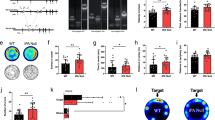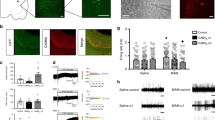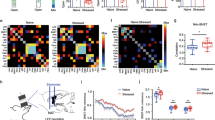Abstract
Activin, a member of the transforming growth factor-β superfamily, affords neuroprotection in acute brain injury, but its physiological functions in normal adult brain are largely unknown. Using transgenic (tg) mice expressing a dominant-negative activin receptor mutant under the control of the CaMKIIα promoter in forebrain neurons, we identified activin as a key regulator of γ-aminobutyric acid (GABA)ergic synapses and anxiety-like behavior. In the open field, wild-type (wt) and tg mice did not differ in spontaneous locomotion and exploration behavior. However, tg mice visited inner fields significantly more often than wt mice. In the light–dark exploration test, tg mice made more exits, spent significantly more time on a well-lit elevated bar and went farther away from the dark box as compared to wt mice. In addition, the anxiolytic effect of diazepam was abrogated in tg mice. Thus the disruption of activin receptor signaling produced a low-anxiety phenotype that failed to respond to benzodiazepines. In whole-cell recordings from hippocampal pyramidal cells, enhanced spontaneous GABA release, increased GABA tonus, reduced benzodiazepine sensitivity and augmented GABAB receptor function emerged as likely substrates of the low-anxiety phenotype. These data provide strong evidence that activin influences pre- and postsynaptic components of GABAergic synapses in a highly synergistic fashion. Given the crucial role of GABAergic neurotransmission in emotional states, anxiety and depression, dysfunctions of activin receptor signaling could be involved in affective disorders: and drugs affecting this pathway might show promise for psychopharmacological treatment.
This is a preview of subscription content, access via your institution
Access options
Subscribe to this journal
Receive 12 print issues and online access
$259.00 per year
only $21.58 per issue
Buy this article
- Purchase on Springer Link
- Instant access to full article PDF
Prices may be subject to local taxes which are calculated during checkout








Similar content being viewed by others
References
Werner S, Alzheimer C . Roles of activin in tissue repair, fibrosis, and inflammatory disease. Cytokine Growth Factor Rev 2006; 17: 157–171.
Mathews LS, Vale WW . Molecular and functional characterization of activin receptors. Receptor 1993; 3: 173–181.
Tsuchida K, Nakatani M, Yamakawa N, Hashimoto O, Hasegawa Y, Sugino H . Activin isoforms signal through type I receptor serine/threonine kinase ALK7. Mol Cell Endocrinol 2004; 220: 59–65.
Wu DD, Lai M, Hughes PE, Sirimanne E, Gluckman PD, Williams CE . Expression of the activin axis and neuronal rescue effects of recombinant activin A following hypoxic-ischemic brain injury in the infant rat. Brain Res 1999; 835: 369–378.
Hughes PE, Alexi T, Williams CE, Clark RG, Gluckman PD . Administration of recombinant human Activin-A has powerful neurotrophic effects on select striatal phenotypes in the quinolinic acid lesion model of Huntington's disease. Neuroscience 1999; 92: 197–209.
Tretter YP, Hertel M, Munz B, ten Bruggencate G, Werner S, Alzheimer C . Induction of activin A is essential for the neuroprotective action of basic fibroblast growth factor in vivo. Nat Med 2000; 6: 812–815.
Muller MR, Zheng F, Werner S, Alzheimer C . Transgenic mice expressing dominant-negative activin receptor IB in forebrain neurons reveal novel functions of activin at glutamatergic synapses. J Biol Chem 2006; 281: 29076–29084.
Mayford M, Mansuy IM, Muller RU, Kandel ER . Memory and behavior: a second generation of genetically modified mice. Current Biol 1997; 7: R580–R589.
Bukalo O, Fentrop N, Lee AY, Salmen B, Law JW, Wotjak CT et al. Conditional ablation of the neural cell adhesion molecule reduces precision of spatial learning, long-term potentiation, and depression in the CA1 subfield of mouse hippocampus. J Neurosci 2004; 24: 1565–1577.
Schweizer C, Balsiger S, Bluethmann H, Mansuy IM, Fritschy JM, Mohler H et al. The gamma 2 subunit of GABA(A) receptors is required for maintenance of receptors at mature synapses. Mol Cell Neurosci 2003; 24: 442–450.
Fritschy JM, Brunig I . Formation and plasticity of GABAergic synapses: physiological mechanisms and pathophysiological implications. Pharmacol Ther 2003; 98: 299–323.
Brambilla P, Perez J, Barale F, Schettini G, Soares JC . GABAergic dysfunction in mood disorders. Mol Psychiatry 2003; 8: 721–737, 715.
Korpi ER, Sinkkonen ST . GABA(A) receptor subtypes as targets for neuropsychiatric drug development. Pharmacol Ther 2006; 109: 12–32.
Mathis C, Neumann PE, Gershenfeld H, Paul SM, Crawley JN . Genetic analysis of anxiety-related behaviors and responses to benzodiazepine-related drugs in AXB and BXA recombinant inbred mouse strains. Behav Genet 1995; 25: 557–568.
Mathis C, Paul SM, Crawley JN . Characterization of benzodiazepine-sensitive behaviors in the A/J and C57BL/6J inbred strains of mice. Behav Genet 1994; 24: 171–180.
Banks MI, Li TB, Pearce RA . The synaptic basis of GABAA, slow. J Neurosci 1998; 18: 1305–1317.
Farrant M, Nusser Z . Variations on an inhibitory theme: phasic and tonic activation of GABA(A) receptors. Nat Rev Neurosci 2005; 6: 215–229.
Semyanov A, Walker MC, Kullmann DM, Silver RA . Tonically active GABAA receptors: modulating gain and maintaining the tone. Trends Neurosci 2004; 27: 262–269.
Wei W, Faria LC, Mody I . Low ethanol concentrations selectively augment the tonic inhibition mediated by delta subunit-containing GABAA receptors in hippocampal neurons. J Neurosci 2004; 24: 8379–8382.
Stell BM, Brickley SG, Tang CY, Farrant M, Mody I . Neuroactive steroids reduce neuronal excitability by selectively enhancing tonic inhibition mediated by delta subunit-containing GABAA receptors. Proc Natl Acad Sci USA 2003; 100: 14439–14444.
Maguire JL, Stell BM, Rafizadeh M, Mody I . Ovarian cycle-linked changes in GABA(A) receptors mediating tonic inhibition alter seizure susceptibility and anxiety. Nat Neurosci 2005; 8: 797–804.
Scimemi A, Semyanov A, Sperk G, Kullmann DM, Walker MC . Multiple and plastic receptors mediate tonic GABAA receptor currents in the hippocampus. J Neurosci 2005; 25: 10016–10024.
Jensen K, Chiu CS, Sokolova I, Lester HA, Mody I . GABA transporter-1 (GAT1)-deficient mice: differential tonic activation of GABAA versus GABAB receptors in the hippocampus. J Neurophysiol 2003; 90: 2690–2701.
Frahm C, Engel D, Draguhn A . Efficacy of background GABA uptake in rat hippocampal slices. Neuroreport 2001; 12: 1593–1596.
Engel D, Schmitz D, Gloveli T, Frahm C, Heinemann U, Draguhn A . Laminar difference in GABA uptake and GAT-1 expression in rat CA1. J Physiol (Lond) 1998; 512: 643–649.
Overstreet LS, Jones MV, Westbrook GL . Slow desensitization regulates the availability of synaptic GABA(A) receptors. J Neurosci 2000; 20: 7914–7921.
Minelli A, Barbaresi P, Conti F . Postnatal development of high-affinity plasma membrane GABA transporters GAT-2 and GAT-3 in the rat cerebral cortex. Brain Res Dev Brain Res 2003; 142: 7–18.
Wafford KA, Thompson SA, Thomas D, Sikela J, Wilcox AS, Whiting PJ . Functional characterization of human gamma-aminobutyric acidA receptors containing the alpha 4 subunit. Mol Pharmacol 1996; 50: 670–678.
Pirker S, Schwarzer C, Wieselthaler A, Sieghart W, Sperk G . GABA(A) receptors: immunocytochemical distribution of 13 subunits in the adult rat brain. Neuroscience 2000; 101: 815–850.
Prenosil GA, Schneider Gasser EM, Rudolph U, Keist R, Fritschy JM, Vogt KE . Specific subtypes of GABAA receptors mediate phasic and tonic forms of inhibition in hippocampal pyramidal neurons. J Neurophysiol 2006; 96: 846–857.
Bowery NG, Bettler B, Froestl W, Gallagher JP, Marshall F, Raiteri M et al. International Union of Pharmacology. XXXIII. Mammalian gamma-aminobutyric acid(B) receptors: structure and function. Pharmacol Rev 2002; 54: 247–264.
Pearce RA, Grunder SD, Faucher LD . Different mechanisms for use-dependent depression of two GABAA-mediated IPSCs in rat hippocampus. J Physiol (Lond) 1995; 484: 425–435.
Sodickson DL, Bean BP . GABAB receptor-activated inwardly rectifying potassium current in dissociated hippocampal CA3 neurons. J Neurosci 1996; 16: 6374–6385.
Glykys J, Mody I . The main source of ambient GABA responsible for tonic inhibition in the mouse hippocampus. J Physiol (Lond) 2007; 582: 1163–1178.
Sik A, Hajos N, Gulacsi A, Mody I, Freund TF . The absence of a major Ca2+ signaling pathway in GABAergic neurons of the hippocampus. Proc Natl Acad Sci USA 1998; 95: 3245–3250.
Tretter YP, Munz B, Hübner G, ten Bruggencate G, Werner S, Alzheimer C . Strong induction of activin expression after hippocampal lesion. Neuroreport 1996; 7: 1819–1823.
McDowell N, Zorn AM, Crease DJ, Gurdon JB . Activin has direct long-range signalling activity and can form a concentration gradient by diffusion. Current Biol 1997; 7: 671–681.
Caraiscos VB, Elliott EM, You-Ten KE, Cheng VY, Belelli D, Newell JG et al. Tonic inhibition in mouse hippocampal CA1 pyramidal neurons is mediated by alpha5 subunit-containing gamma-aminobutyric acid type A receptors. Proc Natl Acad Sci USA 2004; 101: 3662–3667.
Leidenheimer NJ, Whiting PJ, Harris RA . Activation of calcium-phospholipid-dependent protein kinase enhances benzodiazepine and barbiturate potentiation of the GABAA receptor. J Neurochem 1993; 60: 1972–1975.
Mody I . Aspects of the homeostaic plasticity of GABAA receptor-mediated inhibition. J Physiol (Lond) 2005; 562: 37–46.
Crestani F, Lorez M, Baer K, Essrich C, Benke D, Laurent JP et al. Decreased GABAA-receptor clustering results in enhanced anxiety and a bias for threat cues. Nat Neurosci 1999; 2: 833–839.
Fritschy JM, Mohler H . GABAA-receptor heterogeneity in the adult rat brain: differential regional and cellular distribution of seven major subunits. J Comp Neurol 1995; 359: 154–194.
Fritschy JM, Sidler C, Parpan F, Gassmann M, Kaupmann K, Bettler B et al. Independent maturation of the GABA(B) receptor subunits GABA(B1) and GABA(B2) during postnatal development in rodent brain. J Comp Neurol 2004; 477: 235–252.
Takigawa T, Alzheimer C . Phasic and tonic attenuation of EPSPs by inward rectifier K+ channels in rat hippocampal pyramidal cells. J Physiol (Lond) 2002; 539: 67–75.
Takigawa T, Alzheimer C . Interplay between activation of GIRK current and deactivation of Ih modifies temporal integration of excitatory input in CA1 pyramidal cells. J Neurophysiol 2003; 89: 2238–2244.
Mitchell SJ, Silver RA . Shunting inhibition modulates neuronal gain during synaptic excitation. Neuron 2003; 38: 433–445.
Collinson N, Kuenzi FM, Jarolimek W, Maubach KA, Cothliff R, Sur C et al. Enhanced learning and memory and altered GABAergic synaptic transmission in mice lacking the alpha 5 subunit of the GABAA receptor. J Neurosci 2002; 22: 5572–5580.
Bannerman DM, Rawlins JN, McHugh SB, Deacon RM, Yee BK, Bast T et al. Regional dissociations within the hippocampus—memory and anxiety. Neurosci Biobehav Rev 2004; 28: 273–283.
Bannerman DM, Grubb M, Deacon RM, Yee BK, Feldon J, Rawlins JN . Ventral hippocampal lesions affect anxiety but not spatial learning. Behav Brain Res 2003; 139: 197–213.
Yee BK, Zhu SW, Mohammed AH, Feldon J . Levels of neurotrophic factors in the hippocampus and amygdala correlate with anxiety- and fear-related behaviour in C57BL6 mice. J Neural Transm 2007; 114: 431–444.
Mayford M, Bach ME, Huang YY, Wang L, Hawkins RD, Kandel ER . Control of memory formation through regulated expression of a CaMKII transgene. Science 1996; 274: 1678–1683.
Cryan JF, Kaupmann K . Don’t worry ‘B’ happy!: a role for GABA(B) receptors in anxiety and depression. Trends Pharmacol Sci 2005; 26: 36–43.
Mombereau C, Kaupmann K, Froestl W, Sansig G, van der Putten H, Cryan JF . Genetic and pharmacological evidence of a role for GABA(B) receptors in the modulation of anxiety- and antidepressant-like behavior. Neuropsychopharmacol 2004; 29: 1050–1062.
Mombereau C, Kaupmann K, Gassmann M, Bettler B, van der Putten H, Cryan JF . Altered anxiety and depression-related behaviour in mice lacking GABAB(2) receptor subunits. Neuroreport 2005; 16: 307–310.
Cryan JF, Kelly PH, Chaperon F, Gentsch C, Mombereau C, Lingenhoehl K et al. Behavioral characterization of the novel GABAB receptor-positive modulator GS39783 (N,N-dicyclopentyl-2-methylsulfanyl-5-nitro-pyrimidine-4,6-diamine): anxiolytic-like activity without side effects associated with baclofen or benzodiazepines. J Pharmacol Exp Ther 2004; 310: 952–963.
Dow AL, Russell DS, Duman RS . Regulation of activin mRNA and Smad2 phosphorylation by antidepressant treatment in the rat brain: effects in behavioral models. J Neurosci 2005; 25: 4908–4916.
Acknowledgements
We thank Didier Gremelle for technical assistance. We are grateful to Prof Dr Werner Sieghart (Vienna, Austria) for providing antibodies against the α4- and δ-subunit. This work was supported by the ETH Zurich, the Swiss National Science Foundation (grant no. 3100A0-109340/1 to SW) and the University of Kiel (to CA).
Author information
Authors and Affiliations
Corresponding author
Additional information
Supplementary Information accompanies the paper on the Molecular Psychiatry website (http://www.nature.com/mp)
Supplementary information
Rights and permissions
About this article
Cite this article
Zheng, F., Adelsberger, H., Müller, M. et al. Activin tunes GABAergic neurotransmission and modulates anxiety-like behavior. Mol Psychiatry 14, 332–346 (2009). https://doi.org/10.1038/sj.mp.4002131
Received:
Revised:
Accepted:
Published:
Issue Date:
DOI: https://doi.org/10.1038/sj.mp.4002131
Keywords
This article is cited by
-
Neuroadaptations and TGF-β signaling: emerging role in models of neuropsychiatric disorders
Molecular Psychiatry (2022)
-
Dentate gyrus activin signaling mediates the antidepressant response
Translational Psychiatry (2021)
-
Activin Controls Ethanol Potentiation of Inhibitory Synaptic Transmission Through GABAA Receptors and Concomitant Behavioral Sedation
Neuropsychopharmacology (2016)
-
Kdm6b and Pmepa1 as Targets of Bioelectrically and Behaviorally Induced Activin A Signaling
Molecular Neurobiology (2016)
-
Smad3 is required for the survival of proliferative intermediate progenitor cells in the dentate gyrus of adult mice
Cell Communication and Signaling (2013)



